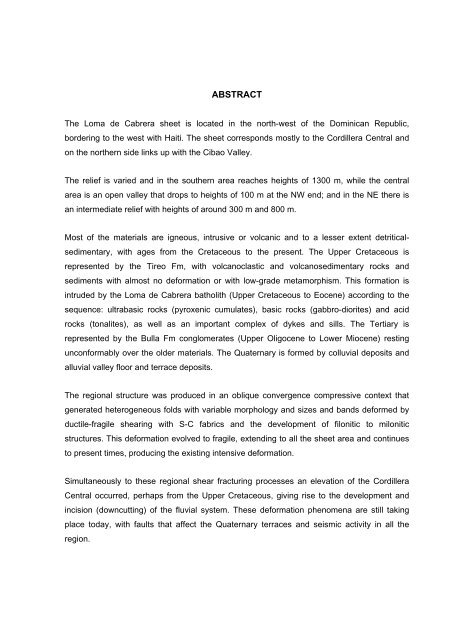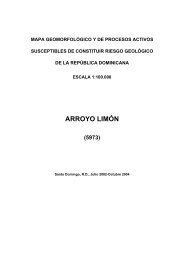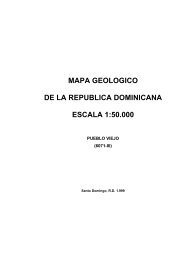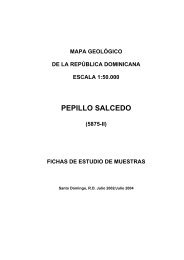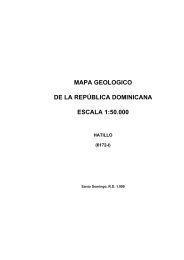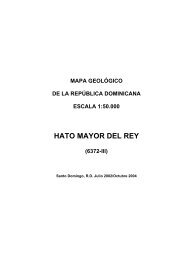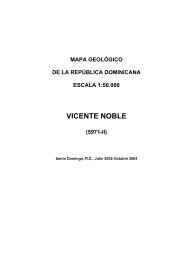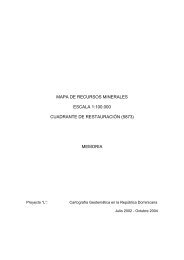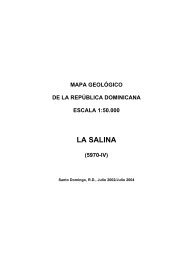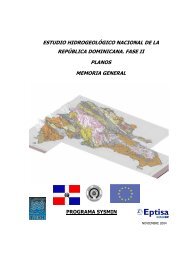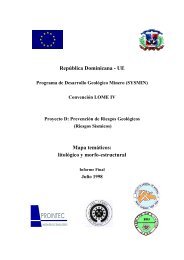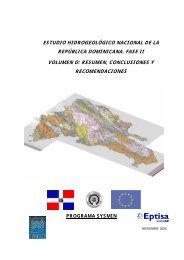LOMA DE CABRERA - mapas del IGME - Instituto Geológico y ...
LOMA DE CABRERA - mapas del IGME - Instituto Geológico y ...
LOMA DE CABRERA - mapas del IGME - Instituto Geológico y ...
You also want an ePaper? Increase the reach of your titles
YUMPU automatically turns print PDFs into web optimized ePapers that Google loves.
ABSTRACT<br />
The Loma de Cabrera sheet is located in the north-west of the Dominican Republic,<br />
bordering to the west with Haiti. The sheet corresponds mostly to the Cordillera Central and<br />
on the northern side links up with the Cibao Valley.<br />
The relief is varied and in the southern area reaches heights of 1300 m, while the central<br />
area is an open valley that drops to heights of 100 m at the NW end; and in the NE there is<br />
an intermediate relief with heights of around 300 m and 800 m.<br />
Most of the materials are igneous, intrusive or volcanic and to a lesser extent detriticalsedimentary,<br />
with ages from the Cretaceous to the present. The Upper Cretaceous is<br />
represented by the Tireo Fm, with volcanoclastic and volcanosedimentary rocks and<br />
sediments with almost no deformation or with low-grade metamorphism. This formation is<br />
intruded by the Loma de Cabrera batholith (Upper Cretaceous to Eocene) according to the<br />
sequence: ultrabasic rocks (pyroxenic cumulates), basic rocks (gabbro-diorites) and acid<br />
rocks (tonalites), as well as an important complex of dykes and sills. The Tertiary is<br />
represented by the Bulla Fm conglomerates (Upper Oligocene to Lower Miocene) resting<br />
unconformably over the older materials. The Quaternary is formed by colluvial deposits and<br />
alluvial valley floor and terrace deposits.<br />
The regional structure was produced in an oblique convergence compressive context that<br />
generated heterogeneous folds with variable morphology and sizes and bands deformed by<br />
ductile-fragile shearing with S-C fabrics and the development of filonitic to milonitic<br />
structures. This deformation evolved to fragile, extending to all the sheet area and continues<br />
to present times, producing the existing intensive deformation.<br />
Simultaneously to these regional shear fracturing processes an elevation of the Cordillera<br />
Central occurred, perhaps from the Upper Cretaceous, giving rise to the development and<br />
incision (downcutting) of the fluvial system. These deformation phenomena are still taking<br />
place today, with faults that affect the Quaternary terraces and seismic activity in all the<br />
region.


